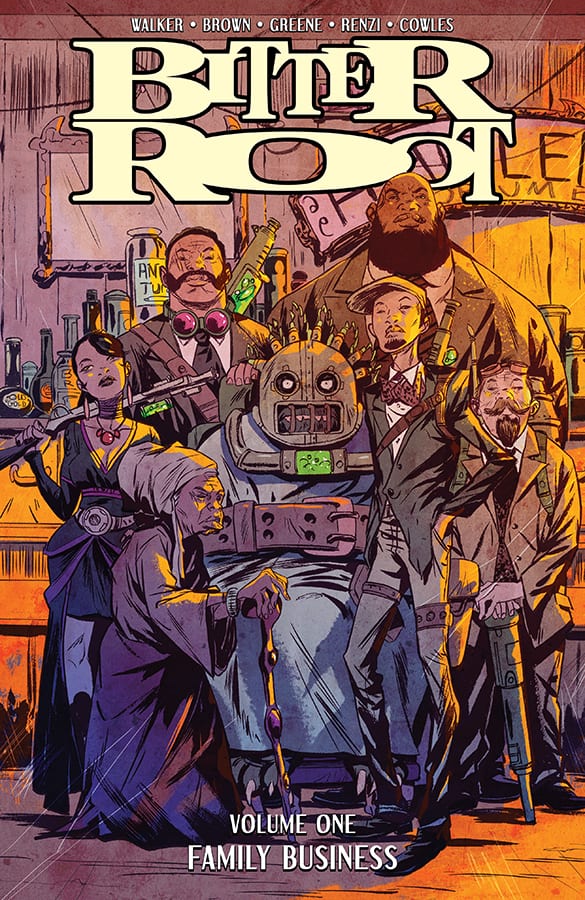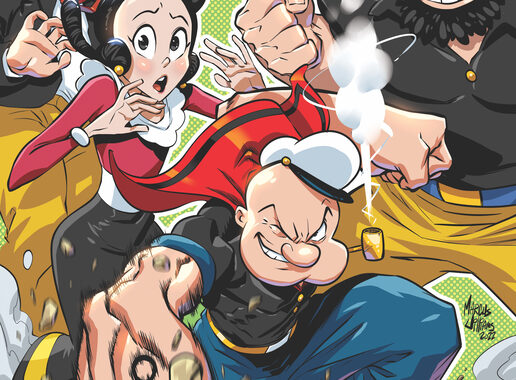
Review: BITTER ROOT TP VOL 01 FAMILY BUSINESS

The title of the first story arc in Image“s groundbreaking series, BITTER ROOT is “Family Business.”“ Family Business has many meanings in American culture, especially in Black American culture. First, family business refers to whatever the family“s legitimate enterprise is. For BITTER ROOT“s Sangerye family that business is salvation. They work roots and beat the devil out of people possessed by racialized evils. Roots work ”“ or workin“ roots is a classic feature of Black diasporic cultural experiences. Folks familiar with Charles Chesnut“s “The Conjure Woman and Other Conjure Tales” know. Or maybe you remember when you read Frederick Douglass“ “Narrative of the Life of . . . an American Slave.” As Douglass reaches his breaking point with the peculiar institution, he is gifted a root by an enigmatic marginal character named Sandy, a root worker/conjure man who instructs him to carry it on his person so that he will never be whipped or beaten by a slaver again. Douglass doesn“t abide by the ethos of conjuring, but he still keeps the root in his pocket and somehow, he is never beaten by a slaver again.
Another meaning of “Family Business”“ is the innerworkings and private relationships of a particular family. Who is that weird uncle who the family doesn“t speak to and why? What ever happened to grandma“s heirloom? Or why do we eat chicken gizzards on Fridays? Family business can often be very personal and for the Sangerye family in BITTER ROOT this is always the case. Created by David F. Walker, Chuck Brown, and Sanford Greene, with kinetic art work from Greene and Rico Renzi, BITTER ROOT“s main family is a tightknit group with a singular focus ”“ to rid the world of its racial demons. This doesn“t mean that tensions don“t exist within the family itself. They do. Blink, a young root-worker is a gifted demon slayer but Ma, the quintessential matriarch of the clan, insists that the traditional role of women in the Sangerye family is in the kitchen, conjuring the vital formulas that can transform devils back into their original human selves. And then there“s Cullen, a bulky, physically imposing devil slayer with an encyclopedic vocabulary. You“ll need a dictionary to appreciate his insightful quips but his exchanges with Berg ”“ a demon slayer who still has a lot to learn ”“ are some of the most humorous in the series. They are all related and all down for the family cause.
That cause, the Sangerye Family“s mission, is as complex as comics can be in the contemporary moment. Some of this complexity is meted out through a series of crafty allusions. The opening scene alludes directly to the real-life Mom and Dad/husband and wife of Black cinematic culture: the late Ossie Davis and Ruby Dee. Still other allusions to early 20th century race riots and the historically tragic fall of “Black Wall Street”“ underscore the “bitter”“ in the title of the series by reminding us of the violent racism that has historically dogged the American “experiment.”“
The concept of the white man as devil has had great purchase in discursive Black life even as it always already revealed its own severe limitations as a feature of any kind of progressive ideology. It seems inconceivable that a comic book would be able to capture this concept“s force as a counter-narrative to anti-Black racism and white supremacy and yet somehow slip the yoke of its negative and reductive sensibilities.
BITTER ROOT does this and more. By depicting the possessed as brutal police men or crazed members of the Ku Klux Klan, BITTER ROOT gets right to the heart of the racial matter of this nation. But by also rendering the condition of racial evil as curable, the creators of this book challenge all of us to reconsider our positions on the great race debates of the 20th and 21st Centuries. Of course, there are Black devils here too ”“ those unfortunate souls who never fully recover from the infliction of racialized hate. Their lot is over-determined by their unchecked desire for revenge and retribution in the never-ending race wars that have gripped the world of BITTER ROOT as well as our own.
If all of this seems like too much for a comic book, or if you find it difficult to keep up with the allusions, the reality and the “realpolitik”“ of race in America, then Walker, Brown, and Greene have enlisted their extended scholarly family, including John Jennings, Regina Bradley, Kinitra Brooks and others, to develop what amounts to a course on these subject matters in the “Bitter Truths”“ sections amongst the back matter of each issue ”“ all wonderfully collected here in the TPB. The result is one of the most engaging, entertaining and critically informative books about race and racial justice in the history of comics. 5/5
[yasr_overall_rating size=”large”]
(W) David Walker, Chuck Brown (A/CA) Sanford Greene
Author Profile
Latest entries
 Comic BooksFebruary 27, 2020Review: Fax From Sarajevo: A Story of Survival
Comic BooksFebruary 27, 2020Review: Fax From Sarajevo: A Story of Survival Comic BooksFebruary 13, 2020Review: BOX OF BONES #1
Comic BooksFebruary 13, 2020Review: BOX OF BONES #1 Comic BooksJanuary 16, 2020Review: HEARTTHROB Season Three #1
Comic BooksJanuary 16, 2020Review: HEARTTHROB Season Three #1 Comic BooksJanuary 8, 2020Review: EXCALIBUR #5
Comic BooksJanuary 8, 2020Review: EXCALIBUR #5






